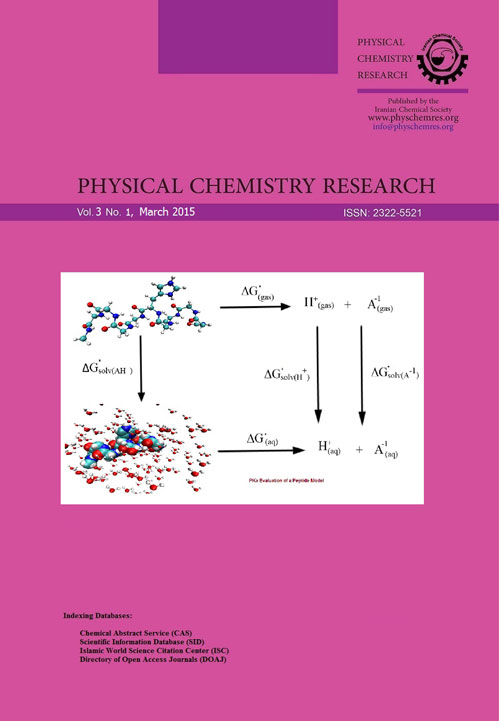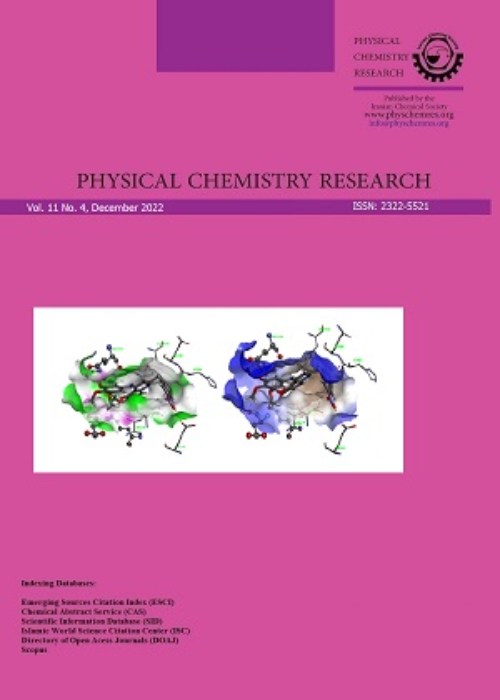فهرست مطالب

Physical Chemistry Research
Volume:3 Issue: 1, Winter 2015
- تاریخ انتشار: 1393/09/09
- تعداد عناوین: 8
-
-
Pages 1-15In this short review we look at recent advances in Schramm-Loewner Evolution (SLE) theory and its application to critical phenomena. The application of SLE goes beyond critical systems to other time dependent, scale invariant phenomena such as turbulence, sand-piles and watersheds. Through the use of SLE, the evolution of conformally invariant paths on the complex plane can be followed; hence a geometrical interpretation is acquired for domain walls in critical phenomena. Also advances made on rigorous mathematical proofs in particular for the Ising and percolation models are noteworthy, giving rise to rigorous results in critical phenomena. On the other hand; application of numerical techniques to SLE for systems far from equilibrium such as surface growth has yielded interesting new results. For example it has yielded results regarding the universality class of certain models which have all been thought to belong to the class of Kardar-Parisi-Zhang model. In this short review we will present some of these results.Keywords: Critical phenomena, Stochastic processes, Conformal invariance
-
Pages 16-23In this paper, the vapor-liquid equilibrium (VLE) properties of polar and nonpolar fluids are modeled by the use of a statistically-based equation of state (EOS). The equation of state used in this work is that of Ihm-Song-Mason (ISM) EOS. An alternative approach is to revise the isothermal integration on liquid. In this respect, a temperature-dependent revision factor b (T) is introduced to the liquid fugacity coefficient expression which was already derived from traditional isothermal integration. By this modification, the vapor pressure of pure liquids can be successfully reproduced using ISM EOS. This equation of state originally cannot predict the vapor pressure of fluids. The novelty of the present work is to introduce a method such that the ISM EOS is able to predict vapor pressure of pure substances and mixtures. Furthermore, the revisionzaSX method is extended to represent the VLE properties of binary mixtures including noble gases, refrigerants and hydrocarbons. Our computation results on the VLE and PVT behaviors of 24 pure substances and 9 binary mixtures are impressive.Keywords: Fugacity coefficient, Vapor, liquid equilibrium, Combining rule
-
Pages 24-34The present study concentrates on the synthesis of Au nanoparticles (AuNPs) using aqueous solution of Polyvinylpyrrolidone (PVP) and tetrachloroaurate by different methods as thermal, sonochemical and electrochemical reduction. The PVP has been used as a reducing agent and acts as a stabilizer for Au nano particles that obtained as principal product. In all synthesis procedures, the active radicals resulted from degradation of PVP caused to reduce the Au ions in the solution. A design of experiment (DOE) techniques, the response surface methodology (RSM) and Taguchi method have been used to optimize the selected experimental parameters. As the size of produced nano particles depends on the reaction conditions, we studied the effect of some factors such as the concentration of HAuCl4, the molecular weight of PVP and the time interval for the sonoechemical synthesis of nano particles by the RSM. In electrochemical synthesis, the Taguchi method has been used to optimize the three parameters, interval time of synthesis, applied current density and concentration of HAuCl4. Characterization of AuNPs was carried out by Transition electron microscopy (TEM), UV-Vis spectroscopy, and particle size analyser. The average size of synthesized nanoparticles in optimum condition, estimated by the particle size analyser, were about 130 nm, 26 nm and 91 nm in thermal, sonochemical and electrochemical methods, respectively.Keywords: Au nanoparticle, PVP, RSM, Taguchi, UV-Vis
-
Pages 35-45In this study, a generalized equation is presented to calculate vapor pressure of pure substances as a function of reduced temperature, critical pressure, and acentric factor. With the presented model, vapor pressures have been calculated and evaluated with NIST data bank for 70 pure substances for about 14000 data points, and the overall average absolute percentage deviation has been only 0.783%. Also the accuracy of obtained model has been evaluated with mostly used equations and the results indicate the superiority of the proposed model against other methods used in this work.Keywords: General equation, Vapor pressure, Pure substances, Thermodynamic properties
-
Pages 46-57The role of nickel as catalyst on the conversion of methane and ethylene in a gas phase flow reactor in the absence of oxygen is studied. In this study, nickel in its different forms is used as catalyst. The role of pressure, flow rate, and temperature on the conversion of feed gases is investigated. The experiments have been carried out in the presence and absence of the catalysts to measure the efficiency of the catalyst activity towards the conversion of the feed gases. Major products have been found to be carbon as soot or coke and hydrogen when methane is used as feed gas. Up to 97% conversion of the ethylene to methane, ethane, hydrogen, and carbon soot were achieved on the surface of the honeycomb nickel catalyst at 900 ± 10 K and 415 ± 5 Torr pressure, while the conversion of methane to hydrogen and carbon on the surface of NiO/SiO2 catalyst was found to be up to 36% at 930 ± 10 K and 490 ± 5 Torr pressure with no sign of C2 or C3 formation. The carbon buildup on the surface of the prepared catalysts is also investigated.Keywords: Nickel catalyst, Methane, ethylene, Hydrogen formation
-
Pages 58-66The model fluids containing hard ellipses (HEs) and Gay-Berne (GB) particles where their center is moving in one dimension and confined between two parallel walls with different interactions are investigated using Monte Carlo simulation, NVT ensemble. The dependency of fluid pressure with respect to the wall distances is studied. The oscillatory behaviors are seen in this quantity against wall separations. The total average number density profile of particles is calculated using the angular number density. For both HE and GB particles confined between hard walls the total average number density at the wall shows a similar oscillatory behavior. We also related the pressure of these systems to the relevant solvation force between two colloidal particles. We have investigated the dependency of this quantity to the packing fraction, temperature, structure of the walls confining the particles and the interaction between ellipses of the fluid. Finally it is possible to reach the required solvation forces by changing the thermodynamic or structural properties.Keywords: Solvation force, Confined fluid, Gay-Berne, Colloids
-
Pages 67-77
In this study, the effect of the secondary structure of the protein on the acid strength of three structures of random (R), alpha helix (α) and beta sheet (b) were investigated theoretically. These structures are related to the cationic amino acids of histidine and lysine in the polypeptide chain of eight-glycine residue. Computational methods at the HF, B3LYP, X3LYP and M05-2X levels in the gas and solution phases were applied. Implicit CPCM solvation model and explicit 2-layer ONIOM methods for the computations in solution were used with the 6-31G (d) basis set. Comparison of pKa values of histidine-based peptide shows that acid strength is accorded to: b > α > R, while in the case of lysine, acid strength is accordance to: α > b > R. Based on the obtained data, ONIOM method is unable to predict the pKa values in the explicit solvation model. NBO analysis showed that one of the main reasons for the increase in the acidity of the solution phase is the increase in delocalization energy difference (ΔEdelocal) of the neutral acid and the corresponding cation. Topological analysis of quantum theory of atoms in molecules for the electron charge density at the bond critical points of the hydrogen bonds of the secondary structures in the presence of the solvent does not show a meaningful correlation with the interaction energy or acid strength. The absolute average ratio of 1.37 and 1.34 for the kinetic energy density to the local potential energy density of lysine and histidine-based peptides, respectively, reveals the non-covalent nature of the O H bonds. Finally, based on the obtained results, pKa of the proteins can be predicted as a function of hydrogen bond characters and their delocalization energy differences between the cationic and neutral forms.
Keywords: Secondary structure, Alpha helix, Beta sheet, Histidine, Lysine, pKa -
Pages 78-88An alumina supported Co/Ni catalyst was prepared by sol-gel procedure to study the catalytic behavior during Fischer-Tropsch synthesis in a fixed-bed reactor. The effect of CO conversion (10-50%) on hydrocarbon product distribution (CH4, C5 and C2-C4 olefin selectivities) was studied. Selectivity for CH4 decreased, while those of C5 and olefin selectivities increased with increasing CO conversion. The catalysts properties were characterized at different stages using powder X-Ray Diffraction (XRD), Brunauer-Emmett-Teller (BET) surface area measurements, and Scanning electron microscopy (SEM). A neuro-fuzzy model called locally liner model tree (LoLiMoT) was applied to predict the catalytic behavior during Fischer-Tropsch reaction over the Co/Ni/Al2O3 catalyst. The predicting system was established on CO conversion values as a target based on three variables, including partial pressure of CO and H2, and H2/CO feed ratios as the input. To evaluate the generalization performance of the system, the k-fold cross validation was applied so that an excellent prediction was observed with mean square error (MSE) which equals 7.4211e-004. Finally, the extrapolation ability of LoLiMoT was perused (beyond the training range). The obtained data from LoLiMoT were compared with the experimental data, and the results indicated that LoLiMoT is a worthy system modeling with high capability for data prediction, both within and beyond the training range.Keywords: locally linear model tree, Cross, validation, Extrapolation, CO conversion, Operational condition, Training range


